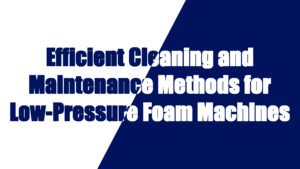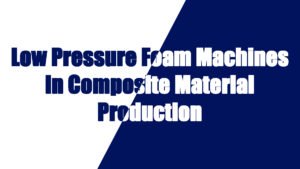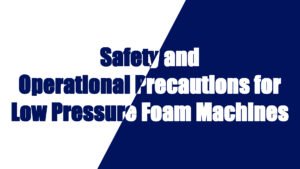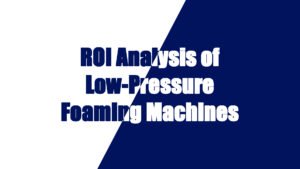Polyurethane foam equipment is widely used in industries such as мебель, строительство, automotive, и упаковка. It is an indispensable part of modern manufacturing. As global market demands continuously evolve and production technologies advance, companies are increasingly focused on improving production efficiency and capacity. Enhancing the efficiency of polyurethane foam production equipment and increasing overall production line capacity has become a key strategy for boosting market competitiveness and reducing production costs. This article will explore the production efficiency of polyurethane foam equipment and discuss ways to improve the overall production capacity of the production line.
Analysis of Production Efficiency of Polyurethane Foam Equipment
The production efficiency of polyurethane foam equipment is influenced by several factors. It is not just about the performance and speed of the equipment, but also the raw material ratios, production processes, and equipment maintenance. Efficient equipment can complete the foaming process in a shorter time, reduce waste, and produce high-quality products consistently, thereby improving overall capacity.
Automation and Efficient Management
Modern PU foam machine typically features highly automated control systems, including automatic material dosing, mixing, foaming, and cutting. These automated functions minimize human intervention, improving precision and speed. The control systems also monitor material consumption in real-time, ensuring accurate mixing ratios, which further boosts production efficiency. In addition, intelligent management systems collect real-time operational data, helping operators detect problems and optimize production processes, which further enhances equipment operational efficiency.
Precise Raw Material Control and Efficient Utilization
The ratio of raw materials in the foaming process is crucial. Using too much or too little material can negatively impact foam quality and production efficiency. Efficient equipment is equipped with precise dosing systems that ensure optimal material ratios for each foaming cycle, reducing waste and improving raw material utilization. Moreover, the precise control of the process ensures consistent foam quality, preventing issues caused by improper material ratios, thus further enhancing production efficiency.
Foaming Speed and Production Cycle
The foaming speed and production cycle are direct indicators of equipment efficiency. The design of the equipment and optimization of the foaming process significantly affect the production cycle. High-efficiency equipment can complete the foaming process in less time, thus increasing production per hour or per day. A shorter production cycle means a higher overall capacity, which in turn reduces the cost per unit of production and increases profit margins. Additionally, a shorter production cycle helps reduce production costs, which can improve profitability.
Precise Temperature and Pressure Control
Temperature and pressure are critical factors influencing foam quality and production efficiency. Modern polyurethane foam equipment is typically equipped with advanced temperature and pressure control systems that monitor and adjust these parameters in real-time to ensure stability and consistency during the foaming process. These systems help optimize conditions for the raw material reaction, improving foam quality and shortening the production cycle, thus enhancing production efficiency.
Methods to Improve Overall Production Line Capacity
To further enhance the production efficiency of polyurethane foam equipment and increase overall production line capacity, companies can focus on optimizing equipment selection, refining production processes, and improving automation. Here are some specific strategies:
Reasonable Equipment Selection and Configuration
The selection of equipment should be based on production needs and product characteristics. For example, large-scale production facilities may prefer high-pressure foaming equipment, which is designed to handle larger production volumes. On the other hand, companies that require precision and low-density foaming products may choose low-pressure equipment. Properly selecting and configuring equipment ensures smoother and more efficient production, thereby maximizing overall capacity.
Improving Automation and Smart Technologies
Automation and smart technologies are at the core of improving production efficiency. With the advancement of technology, polyurethane foam equipment is moving toward higher levels of automation and smart functionality. High-efficiency automated equipment reduces the need for manual intervention, enhancing production accuracy and consistency. Moreover, smart production lines can monitor key production data in real-time, allowing for instant adjustments to production parameters such as temperature, pressure, and material ratios, thereby optimizing processes and further boosting production efficiency.
Minimizing Downtime and Equipment Failures
Downtime significantly impacts overall production capacity. Regular maintenance and inspections are essential to reduce equipment failures and improve production efficiency. By establishing a thorough maintenance schedule that includes routine checks, lubrication, cleaning, and timely replacement of worn-out parts, companies can effectively extend equipment life and reduce the likelihood of breakdowns. Furthermore, many modern polyurethane foam equipment units are equipped with intelligent diagnostic systems that allow for real-time monitoring and troubleshooting, helping reduce unexpected downtime and improve overall efficiency.
Optimizing Production Processes and Workflow
Optimizing production processes is another critical factor in improving production efficiency. Analyzing and adjusting parameters such as foaming time, temperature, and pressure helps streamline the foaming process and shorten production cycles. Additionally, efficient workflow design is crucial. For example, arranging production tasks to minimize delays and idle time between operations can reduce unnecessary stoppages and improve overall productivity.
Data-Driven Production and Real-Time Monitoring
As part of the Industry 4.0 and smart manufacturing trend, many polyurethane foam production lines are now equipped with data-driven control and real-time monitoring systems. These systems allow production managers to monitor key data such as raw material consumption, foaming time, equipment status, etc. These insights help with production scheduling, quality control, and efficiency analysis, providing valuable data to further optimize production processes.
Practical Case Studies of Improved Production Efficiency
Several industries have already seen significant improvements in production efficiency by optimizing foam equipment. For example, a large-scale furniture manufacturer introduced high-efficiency polyurethane foam equipment and optimized their production process. As a result, their production cycle was reduced by 30%, and production line capacity increased by 25%. Additionally, raw material consumption was reduced by 18%. The company also increased automation, reducing manual intervention and further boosting production efficiency, while significantly lowering production costs.
Another case study involves an automotive parts manufacturer that optimized its use of polyurethane foam equipment. By integrating smart production scheduling systems, they reduced equipment downtime, resulting in a 20% improvement in production efficiency. The company also extended the lifespan of their equipment through regular maintenance and optimization, reducing the failure rate and further enhancing overall capacity.
Improving the production efficiency of polyurethane foam equipment and increasing overall production line capacity are critical for enhancing a company’s competitiveness in the market. By optimizing equipment selection, improving automation, reducing downtime, and refining production processes, companies can effectively boost production efficiency, reduce costs, and increase capacity. As technology continues to advance, polyurethane foam equipment will play an increasingly important role in optimizing production, controlling quality, and reducing costs, providing companies with a competitive edge in the market.




































